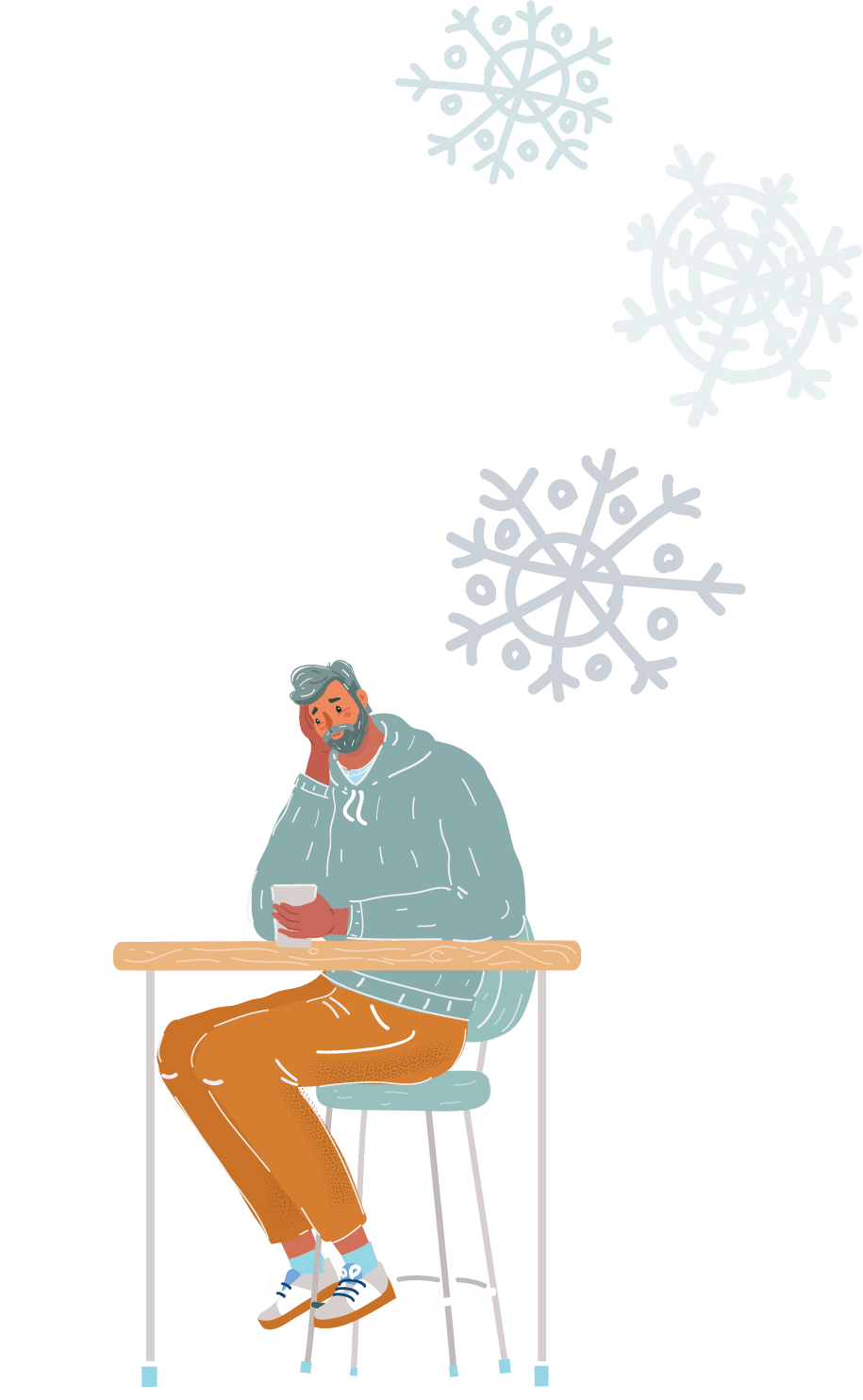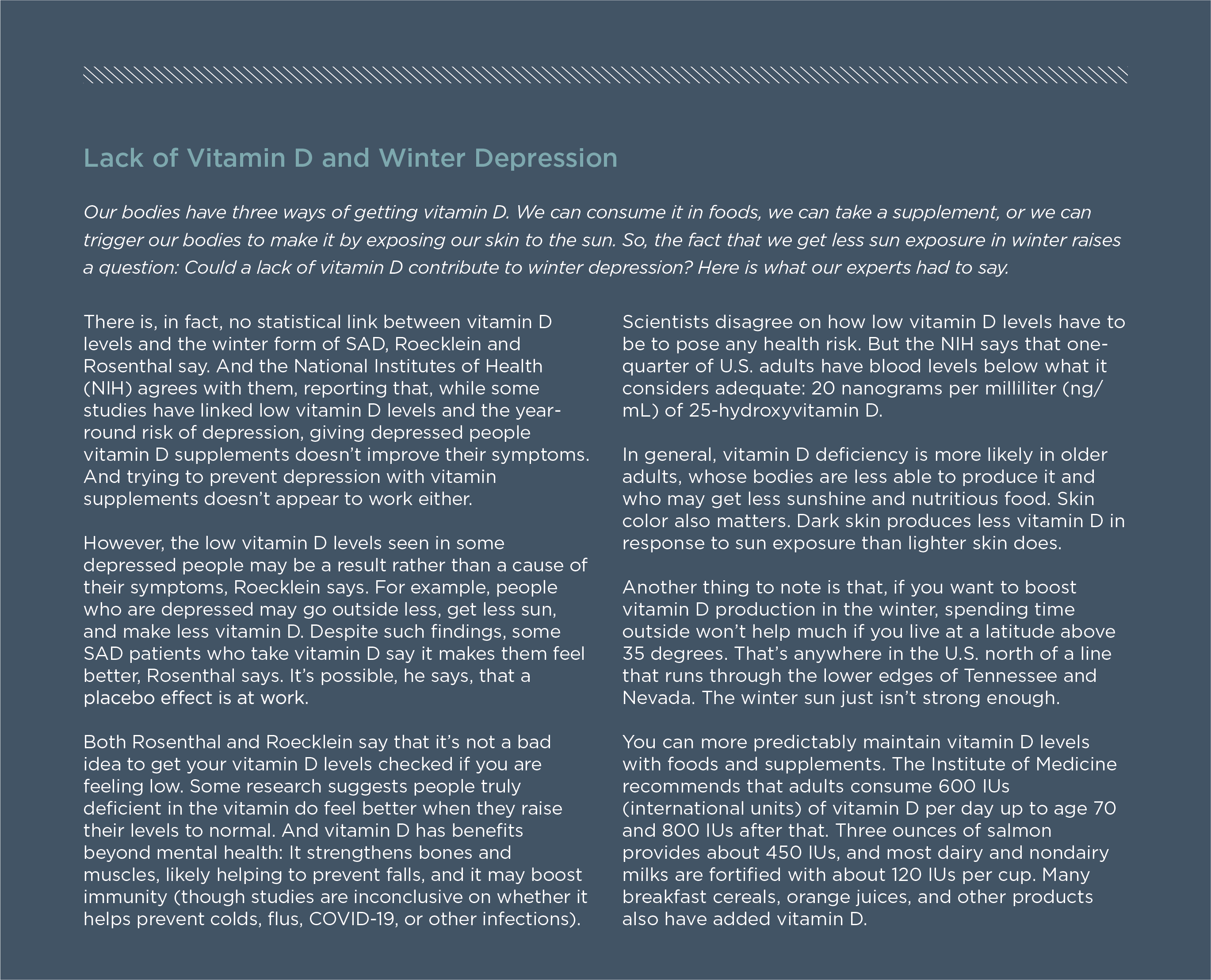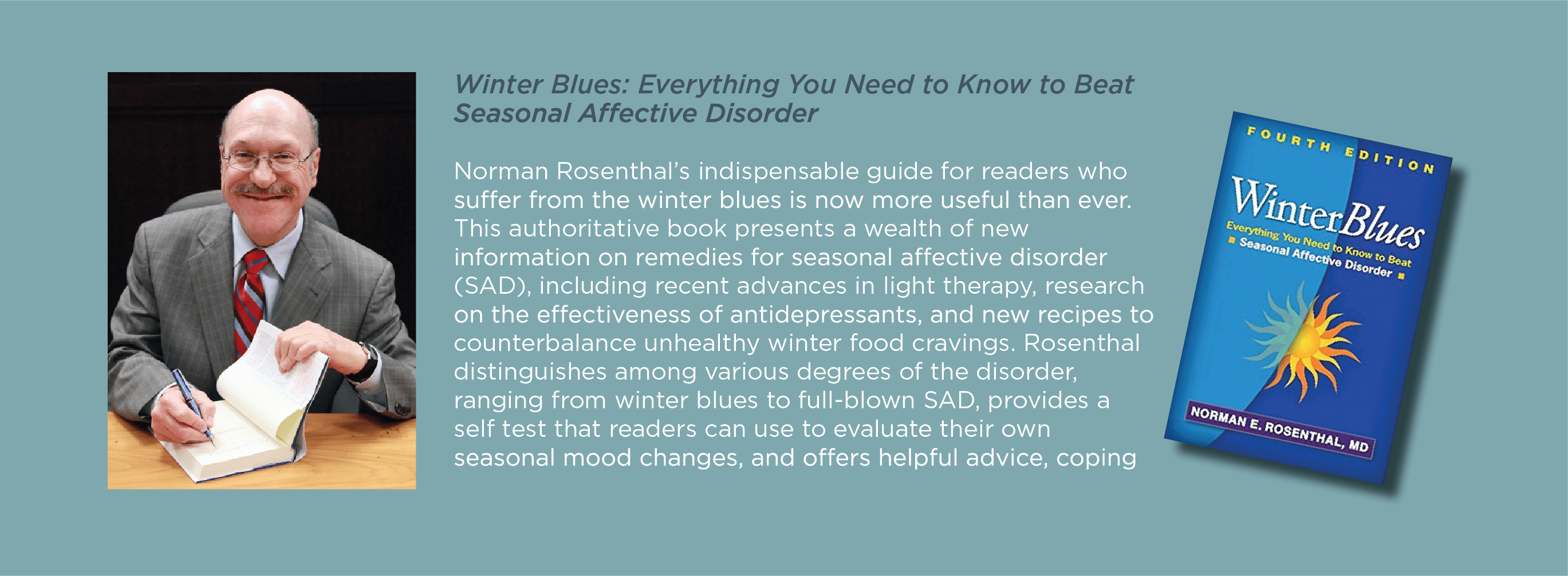Seasonal Blues
For some, fall and winter are exciting times, filled with leaf-peeping, football games, holiday gatherings, and cozy evenings at home. But for others, these chillier, shorter days—and the seasonal loss of light—feel ominous. In more common and less disabling forms, people call this the winter blues. But in its most extreme form, this seasonal shift is known as seasonal affective disorder (SAD).
What is SAD?
SAD is a form of depression that occurs in a seasonal pattern, most often in fall and winter. The symptoms can include all the hallmarks of major depressive disorder, including sadness, hopelessness, fatigue, a loss of interest in life, and changes in eating or sleeping habits.
“People with SAD can suffer just as much as people with any other form of depression,” says Dr. Norman Rosenthal, a clinical professor of psychiatry at Georgetown University School of Medicine. Rosenthal led the team that first recognized SAD as a distinct mental health condition in the 1980s.
Rosenthal says people who experience SAD “can feel suicidal and lose their jobs and lose their relationships. It can be a big deal.”
But SAD is different from other forms of depression in some ways, says Dr. Kathryn Roecklein, an associate professor of psychology at the University of Pittsburgh. Roecklein has devoted her career to finding the biological, psychological, social, and environmental causes of SAD so that she can improve treatment. She says one thing that makes SAD unique is that it is predictable. “It happens year after year, at the same time,” she says.
Also, Roecklein says, people with SAD are less likely than other people with depression to die by suicide, possibly because “hopelessness is less of a problem. People know that spring will come.” She says the average bout of SAD lasts four to six months, while the average instance of major depressive disorder lasts more than a year.
Another difference is a distinctive change in eating habits. People with SAD tend to gain weight as they turn to food for comfort, Roecklein and Rosenthal say. They also report sleeping more, not less, when they are depressed, although Roecklein says her most recent study suggests oversleeping isn’t as typical as once thought.
If you are not clinically depressed but are less cheerful, energetic, creative, and productive in winter, Rosenthal says you may be among the 15 percent of U.S. adults who suffer from the winter blues. Researchers often use a more technical term—subsyndromal SAD—to describe this less severe condition.
What Causes These Problems?

When Rosenthal was growing up in South Africa, he says he noticed the difference in his moods between the warm summers and the cooler winters. But, as he writes in his book, Winter Blues: Everything You Need to Know to Beat Seasonal Affective Disorder, he did not really understand the way winter could deplete his spirits until he spent a year in New York City.
“I had not anticipated how short the days would be,” Rosenthal writes. “Then daylight savings time was over, and the clocks were put back an hour. I left work that first Monday after the time change and found the world in darkness. A cold wind blowing off the Hudson River filled me with foreboding. Winter came. My energy level declined.”
In the spring, he writes, his energy and mood surged again.
Later, Rosenthal and other scientists from the National Institutes of Health (NIH) started to put the pieces together. Certain patients, they noticed, suffered as the hours of daylight declined, with some starting to feel blue by late summer, and most declining by mid-autumn and struggling the most in the dead of winter.
Rosenthal and his colleagues theorized that a shortage of daylight threw some people out of whack, perhaps by disrupting key hormones and the body’s circadian rhythms, the internal clocks that help regulate alertness, mood, and appetite.
They tested this theory by treating some early patients with daily doses of bright light delivered from a huge two-by-four-foot box outfitted with fluorescent fixtures. The result: These patients felt better.
It would take years of research to solidify the theory, but today, seasonal loss of light is accepted as the primary trigger for winter SAD and the milder winter blues.
Is a Lack of Light the Only Cause?
SAD likely has several underlying causes that differ from person to person, Roecklein says.
In fact, many sufferers have retinas that are less sensitive to light. On dull winter days, their eyes might not process light in a way that keeps their circadian rhythms in sync. They feel sleepy and slow in the daytime because their brains haven’t gotten the message that it’s daytime at all.
Psychological factors also matter, Roecklein says. People with SAD, like others with depression, often report stressful or traumatic childhood events. “I want to interview people [who have had stressful or traumatic childhood events] and find out if the negative events happened in winter,” Roecklein says. “Maybe, each winter, the response is to hibernate—to turn inward.” Turning inward, she says, could lead to even less light exposure, less social contact, less exercise, and more pronounced symptoms.
Who is Most at Risk?
Research has found sharp differences in the risk for SAD by latitude, at least in the U.S. The farther north of the equator you live, the more likely you are to suffer, with rates ranging from about 1 percent in Florida to 10 percent in New Hampshire. Curiously, the same clear differences by latitude are not found in Europe, even in countries above the Arctic circle where people routinely experience whole months without daylight. Roecklein says this suggests that factors ranging from cloud cover to culture may be at work.
Women are more likely than men to be depressed, and this gender divide is especially wide when it comes to SAD. Women are four times more likely than men to experience SAD or the winter blues. And while you might suspect that older adults would be especially at risk because they spend more time homebound in the winter—particularly in cold climates—that’s not true. The risk is highest in early adulthood and middle age, Rosenthal says.
One other important risk factor is family history. Forty percent of SAD risk appears to be inherited, Roecklein says.
Can You Screen Yourself for SAD?
In Winter Blues, Rosenthal includes a questionnaire he helped develop called the seasonal pattern assessment questionnaire, or SPAQ. It can be found online and is one of several screening tools researchers use to determine who might have SAD or the winter blues. While Rosenthal says using this questionnaire to screen yourself can be useful, both he and Roecklein say that anyone who believes they are depressed should seek medical help.
What is the Treatment?
Light therapy remains a mainstay in SAD treatment. Today’s light boxes are much smaller than the 1980s prototypes and provide 10,000 lux of light, with harmful ultraviolet rays filtered out. Light use is typically recommended for at least 20 to 30 minutes a day, usually in the morning.
Antidepressant medications and a form of talk therapy called cognitive behavioral therapy also show effectiveness in studies.
Daily habits matter too. Rosenthal says he starts winter days with a stationary bike ride in front of a light box. He says everyone vulnerable to winter sadness should try to exercise, eat healthfully, get outside, and keep up social ties. “You’ve got a choice whether you are going to keep your head under the covers or get up and face the day,” Rosenthal says.
Brightly lit homes and offices and an occasional sun-soaked vacation can help, too, Rosenthal says. Lastly, it’s important to remember: Spring will always come again.

